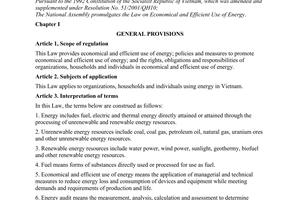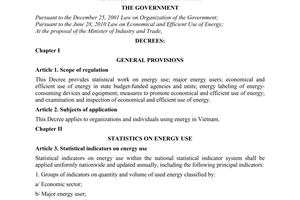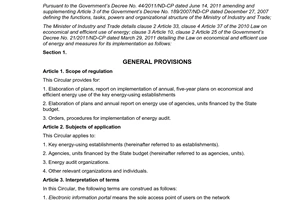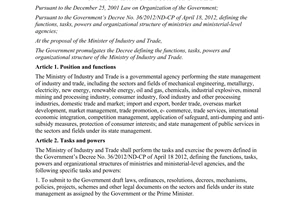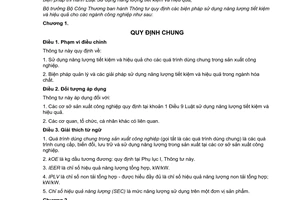Nội dung toàn văn Circular No. 02/2014/TT-BCT solutions for economical and efficient use of energy in industries
|
THE MINISTRY OF
INDUSTRY AND TRADE |
SOCIALIST
REPUBLIC OF VIETNAM |
|
No. 02/2014/TT-BCT |
Hanoi, January 16, 2014 |
CIRCULAR
ON SOLUTIONS FOR ECONOMICAL AND EFFICIENT USE OF ENERGY IN INDUSTRIES
Pursuant to the Law on economical and efficient use of energy dated June 17, 2010;
Pursuant to Decree No. 95/2012/ND-CP dated November 12, 2012 of the Government defining the functions, tasks, entitlements and organizational structure of the Ministry of Industry and Trade;
Pursuant to Decree No. 21/2011/ND-CP dated March 29, 2011 of the Government on guidelines for the Law on economical and efficient use of energy;
The Minister of Industry and Trade promulgates a Circular on solutions for economical and efficient use of energy in industries,
Chapter 1.
GENERAL PROVISIONS
Article 1. Scope
This Circular deals with:
1. Economical and efficient use of energy in general industrial processes.
2. Management and solutions for economical and efficient use of energy in chemical industry.
Article 2. Regulated entities
This Circular applies to:
1. Industrial producers prescribed in Clause 1 Article 9 of the Law on economical and efficient use of energy.
2. Other relevant agencies, organizations, and individuals.
Article 3. Interpretation of terms
1. General processes in industrial production (hereinafter referred to as general processes) mean processes of supply, transformation, storage and use of energy in production in the industrial producers.
2. kOE means kilogram(s) of oil equivalent prescribed in Appendix I of this Circular.
3. IEER means integrated energy efficiency ratio, kW/kW.
4. IPLV means integrated part load value – also known as integrated part load energy efficiency; kW/kW.
5. Specific energy consumption (SEC) means an amount of energy consumed per a unit of product.
Chapter 2.
ECONOMICAL AND EFFICIENT USE OF ENERGY IN GENERAL PROCESSES
SECTION 1. GENERAL REQUIREMENTS
Article 4. Energy efficiency
Energy efficiency in general processes shall be determined as follows:
1. Through energy audit at industrial producers.
2. The energy audit shall be implemented according to the procedures prescribed in Appendix IV of Circular No. 09/2012/TT-BCT dated April 20, 2012 on formulation of plans and reports on implementation of economical and efficient use of energy and energy audit.
Article 5. Management of economical and efficient use of energy in general processes
1. The energy efficiency and energy efficiency targets must be reflected in annual plans and 5-year plans for energy use of industrial producers.
2. The energy efficiency of general processes and achieved targets according to the above plans must be reflected in the energy audit report and annual energy consumption report.
3. The energy efficiency in general processes must satisfy requirements prescribed in this Circular.
4. Industrial producers must have plans to carry out solutions for energy-saving and other solutions as prescribed in this Circular.
5. The solutions for energy-saving shall be studied, supplemented and updated regularly.
SECTION 2. ECONOMICAL AND EFFICIENT USE OF ENERGY IN COMBUSTION PROCESSES
Article 6. General requirements
1. The efficiency of the combustion processes must be controlled to optimize the combustion. In order to optimize the combustion, the following typical excess air are required: CO2 = 14,5 - 15 %, O2 = 2 – 3 %.
2. The amount of air for combustion and exhaust gases shall be measured by an on-the-spot monitoring system or periodically measured by a device or analysis.
3. Appropriate and productive heating equipment is required for economical and efficient use of energy.
4. A fuel process is required to ensure the combustion efficiency.
Article 7. Solutions for economical and efficient use of energy in combustion processes
1. Requirements pertaining to gaseous fuels: ensuring the ratio between air and fuel levels to achieve optimum combustion.
2. Requirements pertaining to liquid fuels
a) Dry the fuel before combustion;
b) Control temperatures;
c) Maintain burners periodically.
3. Requirements pertaining to solid fuels (coal):
a) Determine optimal sizes for various types of incinerators: comply with Section 1.1 Appendix II of this Circular;
b) Ensure optimal moisture: comply with Section 1.1 Appendix II of this Circular;
c) Ensure homogeneity of fuels: comply with Section 1.1 Appendix II of this Circular.
Article 8. Selection of appropriate heating equipment and fuels
1. Select appropriate heating equipment and fuels for economical and efficient use of energy.
2. Increase use of biomass fuel instead of traditional fuels.
3. Strengthen mechanization and automation in fuel supply process.
SECTION 3. ECONOMICAL AND EFFICIENT USE OF ENERGY IN HEAT SUPPLY SYSTEM AND COOLING SYSTEM
Article 9. Requirements and solutions for heat supply system
1. Economical and efficient use of energy in heat supply system must satisfy the following requirements:
a) The thermal efficiency of industrial boilers: ≥ 70% (coal combustion), 80% (oil and gas combustion).
b) Pressure loss in gas transporting pipelines < 3 bars.
c) Heat loss rate in transporting pipelines < 5%.
d) A pipeline system ensuring dilation, condensate discharge and no steam leak.
e) A steam distributing system in accordance with Section 2 Appendix II of this Circular.
2. Solutions
a) Regarding boilers:
- Optimize the fuel combustion;
- Use high-performance heat exchangers;
- Carry out periodic boiler blowdown.
b) Regarding heat transfer system:
- Ensure good insulation;
- Prevent system leakage;
- Make use of the excess heat from waste heat flow of condensate.
Article 10. Requirements pertaining to other heat supply system
1. Fuel and heat loads must satisfy requirements according to design conditions.
2. The heat supply system must be maintained periodically.
3. The system of heating pipelines and insulation must be designed to ensure minimum heat loss.
Article 11. Requirements pertaining to cooling system
1. Select appropriate equipment and technology.
2. Minimum coefficient of performance (COP) prescribed in Section 2.2 of Circular No. 15/2013/TT-BXD dated September 26, 2013 of the Minister of Construction on issuance of National technical regulation on construction works achieving energy efficiency (hereinafter referred to as Circular No. 15/2013/TT-BXD)
3. The cooling system must have high IPLV and IEER coefficients.
Article 12. Solutions for economical and efficient use of energy in cooling system
1. Optimize the heat exchanger.
2. Maintain heat exchanging surface.
3. Adjust power suitable for load of the system.
4. Use multi-level cooling system.
5. Use cold storage system to store cold in off-peak hours for peak hours.
6. Design and maintain the insulation system of the cooling system periodically.
7. Monitor quantity and quality of the refrigerant periodically.
SECTION 4. MAKING USE OF HEAT WASTE FROM SYSTEM OF COMBUSTION, HEAT SUPPLY AND HEAT TRANSFER
Article 13. General requirements
1. Make use of heat waste for other heat-used processes or electricity generation.
2. Quantity of heat waste and potential application: comply with Section 3 Appendix II of this Circular.
Article 14. Solutions for making use of heat waste
1. Install a set of heat exchanger to use heat waste for water supply.
2. Install boilers to make use of heat waste.
3. Use thermal turbines, coil pipeline system, heat pipeline system and gas exchanger.
4. Recover heat from flue gas, engine coolant, engine exhaust, low pressure steam, drying oven exhaust, boiler blowdown.
SECTION 5. ECONOMICAL AND EFFICIENT USE OF ENERGY IN AIR CONDITIONING SYSTEM AND HOT WATER SUPPLY
Article 15. General requirements
1. Economical and efficient use of energy in air conditioning system and hot water supply shall comply with Section 2.2 of Circular No. 15/2013/TT-BXD
2. Design an air conditioning system and hot water supply in accordance with Circular No. 15/2013/TT-BXD
3. The hot water supply for production processes must conform to technology process. The efficiency of this system bases on the efficiency of system of heat supply and heat transfer.
Article 16. Solutions for economical and efficient use of energy in system of heat water supply
1. Use solar energy.
2. Use excess heat water from production process.
3. Use excess steam or heat from production for tap water heating.
4. Use heat from air conditioning system.
5. Use heat pump system.
SECTION 6. POWER LOSS PROTECTION
Article 17. General requirements
The system shall be designed to avoid the following types of losses:
1. Voltage loss.
2. Dephasing loss.
3. Losses due to small power factor.
4. Transformer loss.
5. Increase in electricity purchase costs due to operation in peak hours.
Article 18. Solutions for reducing power losses in the system
1. Increase in voltage transmission. Benefits of high-voltage transmission are prescribed in Section 4.1 Appendix II of this Circular.
2. Selection of transmission lines with appropriate material and section.
3. Performance transformer must be between 85% -95%.
4. Use transformers appropriately through:
a) Select suitable transformer capacity;
b) Operate transformer stations economically;
c) Distribute suitable load between transformers;
d) Place transformer stations near motivation equipment;
e) Do not use a voltage regulator for a motivation circuit when voltage fluctuations occur with no great frequency;
g) Regulate voltage of MBA matching the load;
h) Replace, maintain and repair transformers.
5. Balance phases in electricity system.
6. Increase the power factor of the system through the use of devices with higher power factor or use of capacitors.
7. Manage reasonable electrical load: comply with Section 4.2 Appendix II of this Circular.
SECTION 7. ECONOMICAL AND EFFICIENT USE OF ENERGY IN ELECTRICAL ENGINES
Article 19. General requirements
1. Replace low-performance engines with high-performance engines.
2. Engines with the following features shall be considered replacing:
a) The engine operates at partial load that is below 60-70% of the rated capacity;
b) The engine operates at the rated capacity but it uses adjustable valve or wind leaf with aperture below 60-70% at the output;
c) The engine operates overload in some periods of significant operation;
d) The engine has been used for beyond its allowed service life without overhaul;
e) The engine is used with a significant power change during use but have not used the inverter;
g) Low-performance engine;
h) The engine of which speed is adjusted with rotor resistance.
Article 20. Solutions for economical and efficient use of energy in engines
1. Maintain a voltage supply with a maximum fluctuation range of 5% over the nominal value.
2. Minimize phase unbalance within 1% to avoid reduced engine performance.
3. Maintain high power factor by installing capacitor banks in a position as close to the engine as possible.
4. Select the appropriate engine power to avoid the low efficiency and poor power factor.
5. Ensure that the engine load is greater than 60%.
7. Apply the appropriate maintenance policies for the engine.
8. Use the variable speed drives (VSD) or two-speed motors for the appropriate application.
9. Using inverter for motors with considerate fluctuation power during use and motors of which speed is adjusted by rotor resistance.
10. Replace the engine which is broken, overload or partial load with the high-performance engine.
11. Rewind the engine being burned at the guarantee technical service.
12. Optimize transmission efficiency through maintenance and proper installation of axes, chains, gears, and the transmission belt.
13. Control ambient temperature to extend the insulation life time and reliability of the engine.
14. Maintain engine as recommended by the manufacturer and use high-quality oil or grease to avoid contamination or water.
15. Compensate reactive power for the engine if necessary.
16. When replacing or fitting the controller for the engine, it is required to note the characteristics of the motor and load to ensure improvement plans can operate effectively in a technological process of the system.
SECTION 8. LIGHTING TECHNOLOGY AND MANAGEMENT IN PLANTS AND OFFICES OF ENTERPRISES
Article 21. General requirements
Lighting system in offices and workshops in industrial plants must conform to the following requirements:
1. Ensure the necessary brightness at the working positions.
2. Ensure brightness with minimal power consumption.
Article 22. Solutions for economical and efficient use of energy in lighting system
1. In order to ensure efficient lighting system, the following requirements must be satisfied:
a) Design a conformable lighting system;
b) Use right types of energy-saving lamps for appropriate areas;
c) Using sensors to turn lights on or off on demand(light intensity sensors, movement sensors, timers);
d) Use the lampshades to enhance lighting;
e) Use accessories effectively;
g) Use capacitors to increase power factor.
2. Regarding offices: apply technical standards prescribed in Section 2.3 of Circular No. 15/2013/TT-BXD
3. Regarding plants: apply Vietnam’s Standards 7114:2002 (2008) for lighting system inside the buildings. Lighting range recommended for a number of typical industrial producers: comply with Section 5.1 Appendix II of this Circular. When replacing the energy-saving lamps, it should pay attention to lighting characteristics and lighting requirements of the work area to select the appropriate lamps. Specifications of a number of popular lamps: comply with Section 5.2 Appendix II of this Circular.
4. Standards for efficient lighting system: comply with Circular No. 15/2013/TT-BXD
SECTION 9. ECONOMICAL AND EFFICIENT USE OF ENERGY IN COMPRESSED AIR SYSTEM
Article 23. Requirements for efficient operation applicable to compressed air system
1. Ensure efficient compressed air supply for the required technology process.
2. Using the best air compressors suitable for the requirements of the system. Criteria for selecting air compressors: comply with Section 6.1 Appendix II of this Circular. Minimize losses during compressed air supply to the technology equipment.
Article 24. Solutions for economical and efficient use of energy in compressed air system
1. Ensure quality of input gas of compressors: clean, dry and cool; air temperature affect to the energy efficiency of the compressor prescribed in section 6.2 Appendix II of this Circular. Reduce pressure drop at the filter inlet to avoid reducing compressor performance. The impact of the pressure drop across the filter on the power consumption specified in Section 6.3 Appendix II of this Circular.
2. Find and handle compressed air leak and prevent leakage. Regularly check for any leaks and pressure losses in the whole system (monthly).
3. Adjusting operations in consumers at the lowest possible pressure.
4. Close all gas supplies to the equipment is not operating.
5. Isolate single device using high-pressure compressed air.
6. Monitor the pressure drops in pipeline distribution system.
7. When one or multiple compressors for a general distribution, the compressor shall be operated so that the production cost of compressed air is minimized.
9. Consider using multi-level compressors.
10. Reduce the pressure as low as possible.
11. Avoid putting higher-pressure compressed air to the whole line just to meet the need of a high-voltage equipment.
12. Apply preventive maintenance strategy systematically for compressors and auxiliary parts.
13. Ensure that the condensate must be removed from the distribution system immediately or no condensate.
14. Check out that the sizes of tanks can either contain enough air for the huge demand in the short term or not.
Chapter 3.
ENERGY-CONSUMPTION RATES AND REQUIREMENTS FOR ECONOMICAL AND EFFICIENT USE OF ENERGY IN INDUSTRIES
SECTION 1. SPECIFIC ENERGY CONSUMPTION AND IMPROVEMENTS IN ENERGY EFFICIENCY
Article 25. Determination of specific energy consumption and improvements in energy efficiency in industrial producers
1. Specific energy consumption (SEC) shall be determined according to the procedures prescribed in Appendix III of this Circular.
2. SEC shall be determined according to a unit of typical products of an industry (metric tons of products, units of products, etc.). In case the industrial producer has various types of output products, they shall be converted to a typical product.
3. The SEC of the producer shall be compared with the rated energy consumption (or average energy consumption of the industry) to decide the level of improvement in energy efficiency.
4. The level of improvement in energy efficiency shall be prescribed according to the industry, technology level, production scale and production features of the industrial producer. The proposed level of improvement shall be prescribed according to plan stages.
5. Industrial producers shall report specific energy consumption and level of improvements in energy efficiency achieved in comparison with the annual plans.
SECTION 2. IMPROVEMENTS IN ENERGY EFFICIENCY IN CHEMICAL INDUSTRY
Article 26. Specific energy consumption and improvements in energy efficiency in chemical industry
1. Raw rubber production sector.
a) Levels of energy consumption (refer to Section 1.1 of Appendix IV):
- For producers with a capacity of less than 5,000 metric tons per year: 44 kOE per tonne (commercial products);
- For producers with a capacity of between 5,000 metric tons and 10,000 metric tons per year: 36 kOE per tonne (commercial products);
- For producers with a capacity of 10,000 metric tons or more per year: 28 kOE per tonne (commercial products);
b) Improvements in energy efficiency:
- For producers having consumption level higher than rated level: carry out solutions for economical and efficient use of energy;
- For producers having consumption level equal to rated level or lower : keep maintaining and improving technology.
2. NPK fertilizer production sector
a) Levels of energy consumption (refer to Section 1.2 of Appendix IV)
- For producers with a capacity of less than 4,000 metric tons per year: 14.8 kOE per tonne (commercial products);
- For producers with a capacity of between 4,000 metric tons and 9,000 metric tons per year: 16.8 kOE per tonne (commercial products);
- For producers with a capacity of 9,000 metric tons or more per year: 19.7 kOE per tonne (commercial products);
b) Improvements in energy efficiency:
- For producers having consumption level higher than rated level : carry out solutions for economical and efficient use of energy;
- For producers having consumption level equal to rated level or lower: keep maintaining and improving technology.
3. Water paint production sector
a) Levels of energy consumption (refer to Section 1.3 of Appendix IV):
- Average level of energy consumption: 12.1 kOE per tonne (commercial products).
b) Improvements in energy efficiency:
- For producers having consumption level higher than rated level: carry out solutions for economical and efficient use of energy;
- For producers having consumption level equal to rated level or lower: keep maintaining and improving technology.
4. Solvent paint production sector
a) Levels of energy consumption (refer to Section 1.4 of Appendix IV):
- Average level of energy consumption: 17.7 kOE per tonne (commercial products).
b) Improvements in energy efficiency:
- For producers having consumption level higher than rated level: carry out solutions for economical and efficient use of energy;
- For producers having consumption level higher than rate level: keep maintaining and improving technology.
Article 27. Solutions for improvements in energy efficiency in chemical industry
1. Raw rubber production section
a) Use high-performance engines;
b) Convert current for compressor components (packaging);
c) Gasification from wood to fuel oil / LPG for material drying system;
d) Solutions for sewage treatment system;
- Changing from surface aeration by aeration refined;
- Biogas from sewage treatment system.
e) Improve energy management.
2. NPK fertilizer production sector
a) Reduce circulation factor in the production process;
b) Use high-performance engines;
c) Use optimal inverter for fans and pumps;
d) Using heat waste in cooling stages for drying materials;
e) Improve energy management;
3. Paint and solvent paint production sector
- Use high-performance engines;
- Optimize compressed air system;
- Improve energy management.
Chapter 4.
IMPLEMENTATION
Article 28. Responsibility of General Department of Energy
1. Monitor and inspect the management of energy efficiency in industrial producers.
2. Carry out management of energy efficiency as prescribed in this Circular.
3. Determine and update quotas on energy consumption in industries for management of energy efficiency.
Article 29. Responsibility of Services of Industry and Trade
1. Cooperate with General Department of Energy in guidelines and inspection of implementation of economical and efficient use of energy as prescribed in this Circular.
2. Inspect the implementation of this Circular within their administrative divisions.
3. Take charge and cooperate with Services in inspection and guidelines for industrial producers to implement this Circular.
Article 30. Implementation
1. This Circular comes into effect from June 1, 2014.
2. Difficulties that arise during the implementation of this Circular should be reported to the Ministry of Industry and Trade for consideration.
|
|
PP.
MINISTER |
------------------------------------------------------------------------------------------------------
This translation is made by LawSoft and
for reference purposes only. Its copyright is owned by LawSoft
and protected under Clause 2, Article 14 of the Law on Intellectual Property.Your comments are always welcomed
